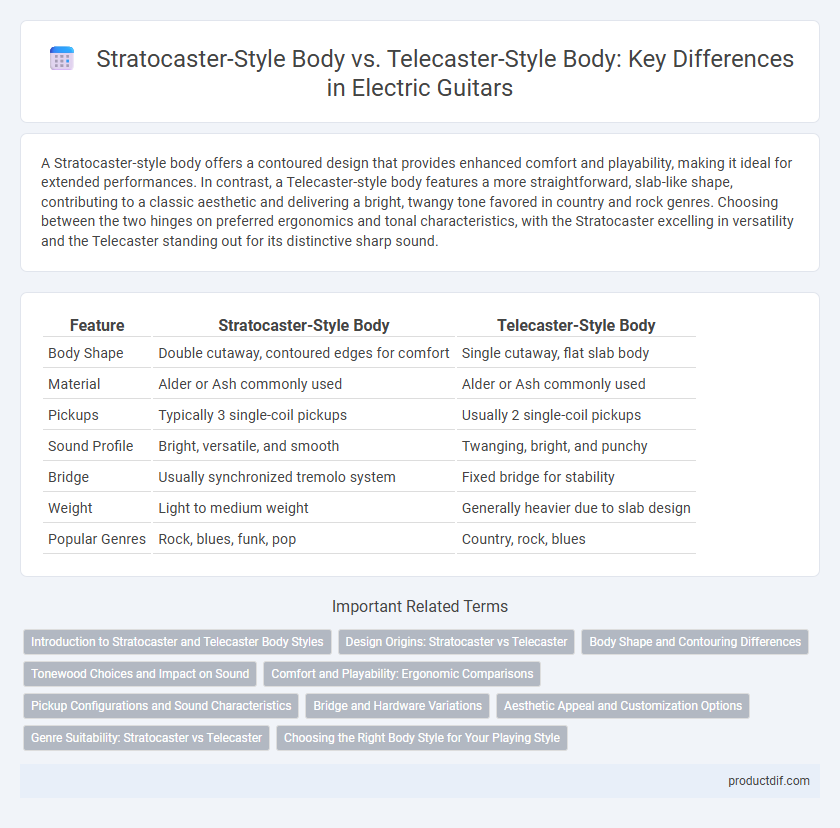A Stratocaster-style body offers a contoured design that provides enhanced comfort and playability, making it ideal for extended performances. In contrast, a Telecaster-style body features a more straightforward, slab-like shape, contributing to a classic aesthetic and delivering a bright, twangy tone favored in country and rock genres. Choosing between the two hinges on preferred ergonomics and tonal characteristics, with the Stratocaster excelling in versatility and the Telecaster standing out for its distinctive sharp sound.
Table of Comparison
| Feature | Stratocaster-Style Body | Telecaster-Style Body |
|---|---|---|
| Body Shape | Double cutaway, contoured edges for comfort | Single cutaway, flat slab body |
| Material | Alder or Ash commonly used | Alder or Ash commonly used |
| Pickups | Typically 3 single-coil pickups | Usually 2 single-coil pickups |
| Sound Profile | Bright, versatile, and smooth | Twanging, bright, and punchy |
| Bridge | Usually synchronized tremolo system | Fixed bridge for stability |
| Weight | Light to medium weight | Generally heavier due to slab design |
| Popular Genres | Rock, blues, funk, pop | Country, rock, blues |
Introduction to Stratocaster and Telecaster Body Styles
Stratocaster-style bodies feature a contoured, double-cutaway design that offers enhanced comfort and playability, while Telecaster-style bodies maintain a single-cutaway, slab design known for its simplicity and bright tone. The Stratocaster body typically includes more ergonomic curves and a beveled edge, contributing to its popularity among rock and blues guitarists. Telecaster bodies are often praised for their solid, straightforward construction, which supports a distinctive twang and sustain favored in country and classic rock genres.
Design Origins: Stratocaster vs Telecaster
The Stratocaster-style body, designed by Leo Fender in 1954, features a contoured, double-cutaway shape that enhances playability and comfort, reflecting innovations aimed at modern electric guitar performance. In contrast, the Telecaster-style body, introduced earlier in 1950, showcases a single-cutaway, slab-like design emphasizing simplicity and durability, rooted in traditional electric guitar aesthetics. Both designs significantly influenced guitar ergonomics and sound, with the Stratocaster's curves enabling versatile playing techniques while the Telecaster's straightforward body maintains a classic tone and robust structure.
Body Shape and Contouring Differences
Stratocaster-style bodies feature a double-cutaway design with extensive contouring for enhanced playability and comfort during prolonged use, including forearm and belly cuts. Telecaster-style bodies exhibit a single-cutaway, slab-like design with minimal contouring, offering a more traditional and straightforward feel. These body shape and contouring differences significantly impact the guitar's ergonomics and player accessibility to higher frets.
Tonewood Choices and Impact on Sound
Stratocaster-style bodies commonly use alder or ash tonewoods, which contribute to bright, balanced tones with pronounced midrange and shimmer, ideal for versatile genres like rock and blues. Telecaster-style bodies often feature ash or sometimes swamp ash, delivering a snappier, twangy sound with strong attack and sustain, favored in country and Americana music. The choice of tonewood in Stratocaster and Telecaster designs significantly influences resonance and tonal clarity, shaping each guitar's distinct sonic character.
Comfort and Playability: Ergonomic Comparisons
Stratocaster-style bodies feature contoured edges and a double-cutaway design, offering enhanced comfort and easier access to higher frets, which benefits players seeking fluid lead playing. Telecaster-style bodies, with their slab design and single-cutaway, provide a solid, stable feel but may lack the ergonomic curves found on Strat models, potentially affecting extended play comfort. The choice depends on prioritizing either the lightweight, ergonomic shaping of the Stratocaster or the traditional, robust build of the Telecaster for playability preferences.
Pickup Configurations and Sound Characteristics
Stratocaster-style bodies typically feature three single-coil pickups with a five-way switch, offering bright, versatile tones and smooth transition between pickups for styles ranging from blues to rock. Telecaster-style bodies usually have two single-coil pickups with a three-way switch, delivering a punchy, sharp sound characterized by a strong midrange and twang, favored in country and rock music. The Strat's pickup configuration allows more tonal variety, while the Tele's simplicity emphasizes clarity and bite.
Bridge and Hardware Variations
Stratocaster-style bodies feature a synchronized tremolo bridge system that allows for expressive pitch bending and vibrato effects, commonly paired with single-coil pickups for bright, versatile tones. Telecaster-style bodies typically utilize a fixed, ashtray-style bridge with three or six saddles, known for providing stable tuning and a distinctive twang favored in country and rock genres. Hardware variations include Stratocasters often having a five-way selector switch and more contouring for player comfort, while Telecasters retain simpler controls and a slab body design, emphasizing raw sustain and punchy attack.
Aesthetic Appeal and Customization Options
Stratocaster-style bodies feature contoured edges and a double-cutaway design, offering a sleek, modern aesthetic favored by rock and blues musicians. Telecaster-style bodies present a single-cutaway, slab shape with a more vintage, minimalist appeal that resonates with country and classic rock players. Customization options for Stratocasters include varied pickup configurations and tremolo bridges, while Telecasters often showcase simpler electronics and unique wood grain finishes, emphasizing tonal versatility and personalized style.
Genre Suitability: Stratocaster vs Telecaster
Stratocaster-style bodies excel in genres like rock, blues, and funk due to their versatile tone and comfortable contoured shape, offering smooth playability and a wide range of sound options with three single-coil pickups. Telecaster-style bodies are favored in country, rockabilly, and classic rock for their bright, twangy sound and simple, solid design that enhances sustain and bite. Guitarists often choose a Stratocaster for expressive lead work and complex tones, while a Telecaster suits rhythm playing and genres requiring crisp, punchy articulation.
Choosing the Right Body Style for Your Playing Style
Stratocaster-style bodies offer contoured edges and double cutaways, enhancing comfort and access to higher frets, ideal for players seeking versatility and ergonomic design. Telecaster-style bodies feature a single cutaway with a slab-like profile, delivering a brighter, twangy tone favored in country and blues genres. Selecting between these shapes depends on your preference for tonal character and playability, matching the body's ergonomic features to your specific playing style.
Stratocaster-style body vs Telecaster-style body Infographic

 productdif.com
productdif.com